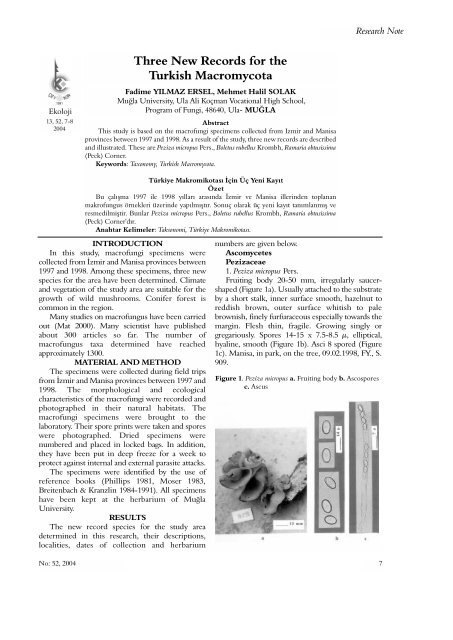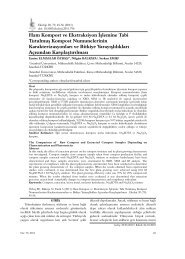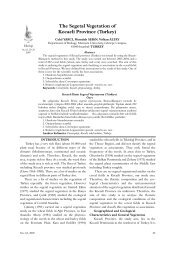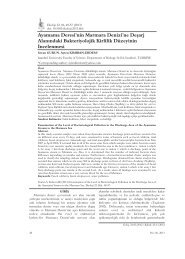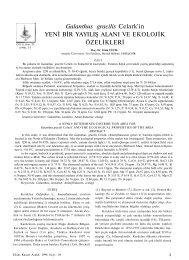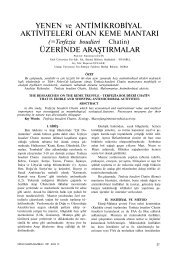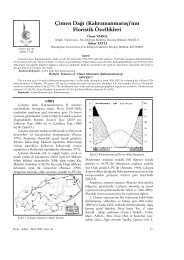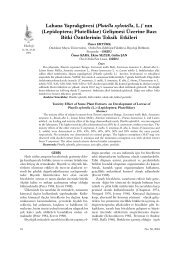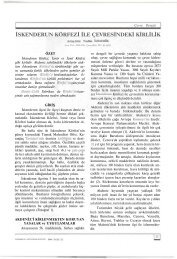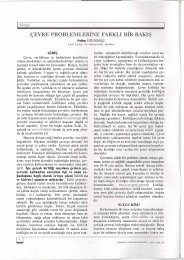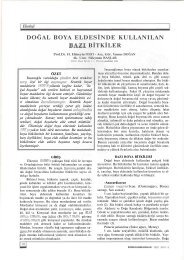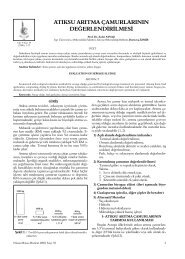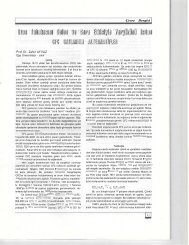Full text: (pdf) - Ekoloji
Full text: (pdf) - Ekoloji
Full text: (pdf) - Ekoloji
Create successful ePaper yourself
Turn your PDF publications into a flip-book with our unique Google optimized e-Paper software.
<strong>Ekoloji</strong><br />
13, 52, 7-8<br />
2004<br />
Fadime YILMAZ ERSEL, Mehmet Halil SOLAK<br />
Muðla University, Ula Ali Koçman Vocational High School,<br />
Program of Fungi, 48640, Ula- MUÐLA<br />
INTRODUCTION<br />
In this study, macrofungi specimens were<br />
collected from Ýzmir and Manisa provinces between<br />
1997 and 1998. Among these specimens, three new<br />
species for the area have been determined. Climate<br />
and vegetation of the study area are suitable for the<br />
growth of wild mushrooms. Conifer forest is<br />
common in the region.<br />
Many studies on macrofungus have been carried<br />
out (Mat 2000). Many scientist have published<br />
about 300 articles so far. The number of<br />
macrofungus taxa determined have reached<br />
approximately 1300.<br />
MATERIAL AND METHOD<br />
The specimens were collected during field trips<br />
from Ýzmir and Manisa provinces between 1997 and<br />
1998. The morphological and ecological<br />
characteristics of the macrofungi were recorded and<br />
photographed in their natural habitats. The<br />
macrofungi specimens were brought to the<br />
laboratory. Their spore prints were taken and spores<br />
were photographed. Dried specimens were<br />
numbered and placed in locked bags. In addition,<br />
they have been put in deep freeze for a week to<br />
protect against internal and external parasite attacks.<br />
The specimens were identified by the use of<br />
reference books (Phillips 1981, Moser 1983,<br />
Breitenbach & Kranzlin 1984-1991). All specimens<br />
have been kept at the herbarium of Muðla<br />
University.<br />
RESULTS<br />
The new record species for the study area<br />
determined in this research, their descriptions,<br />
localities, dates of collection and herbarium<br />
Three New Records for the<br />
Turkish Macromycota<br />
Abstract<br />
This study is based on the macrofungi specimens collected from Izmir and Manisa<br />
provinces between 1997 and 1998. As a result of the study, three new records are described<br />
and illustrated. These are Peziza micropus Pers., Boletus rubellus Krombh, Ramaria obtusissima<br />
(Peck) Corner.<br />
Keywords: Taxonomy, Turkish Macromycota.<br />
Türkiye Makromikotasý Ýçin Üç Yeni Kayýt<br />
Özet<br />
Bu çalýþma 1997 ile 1998 yýllarý arasýnda Ýzmir ve Manisa illerinden toplanan<br />
makrofungus örnekleri üzerinde yapýlmýþtýr. Sonuç olarak üç yeni kayýt tanýmlanmýþ ve<br />
resmedilmiþtir. Bunlar Peziza micropus Pers., Boletus rubellus Krombh, Ramaria obtusissima<br />
(Peck) Corner'dýr.<br />
Anahtar Kelimeler: Taksonomi, Türkiye Makromikotasý.<br />
numbers are given below.<br />
Ascomycetes<br />
Pezizaceae<br />
1. Peziza micropus Pers.<br />
Fruiting body 20-50 mm, irregularly saucershaped<br />
(Figure 1a). Usually attached to the substrate<br />
by a short stalk, inner surface smooth, hazelnut to<br />
reddish brown, outer surface whitish to pale<br />
brownish, finely furfuraceous especially towards the<br />
margin. Flesh thin, fragile. Growing singly or<br />
gregariously. Spores 14-15 x 7.5-8.5 µ, elliptical,<br />
hyaline, smooth (Figure 1b). Asci 8 spored (Figure<br />
1c). Manisa, in park, on the tree, 09.02.1998, FY., S.<br />
909.<br />
Figure 1. Peziza micropus a. Fruiting body b. Ascospores<br />
c. Ascus<br />
Research Note<br />
No: 52, 2004 7
<strong>Ekoloji</strong><br />
Basidiomycetes<br />
Boletaceae<br />
2. Boletus rubellus Krombh<br />
Cap 40-80 mm, convex, nearly plane in age<br />
(Figure 2a), outer surface dry and velvety, dark red<br />
to red brown. Pore surface yellow, becoming<br />
greenish yellow, bruising blue to bluish green, 1-2<br />
pores per mm. Stem, 30-80 mm long, 10-15 mm<br />
thick, tapered downward, reddish, darkening on<br />
handling, yellow at apex. Flesh yellow, staining<br />
slowly blue to bluish green, reddish orange in the<br />
base of the stem. Taste mild, smell not distinctive.<br />
Spores 10-12 x 4-5 µ, elliptic, smooth (Figure 2b).<br />
Ýzmir, Balçova, around Teleferik, 25.10.1998, FY., S.<br />
934.<br />
Ramariaceae<br />
3. Ramaria obtusissima (Peck) Corner<br />
Fruiting body corallike, 100-120 mm across and<br />
90-150 mm tall, tough, branch repeatedly towards<br />
the top, ends of brances with blunt, forks U- to Vshaped,<br />
(Figure 3a). Branches bright, light yellow<br />
when young, light brownish in age, turning<br />
brownish when bruised, branch apex yellow. Flesh<br />
white, soft, odor insignificant. Solitary to grouped.<br />
Spores 11-14 x 3.5-4 µ elliptic, hyaline, with drops<br />
(Figure 3b). Manisa, Sureyya Parký, Pine area,<br />
23.11.1997, FY., S. 845.<br />
8<br />
F. YILMAZ ERSEL, M. H. SOLAK<br />
Figure 2. Boletus rubellus a. Fruiting body b. Basidiosparos<br />
Figure 3. Ramaria obtusissima a. Fruiting body b. Basidiosparos<br />
REFERENCES<br />
Breitenbach J, Kranzlin F (1984-1991) Fungi of Switzerland. Volume 1-3, Verlag Mycologia, CH-<br />
6000 Luzern 9, Switzerland.<br />
Mat A (2000) Türkiye'de Mantar Zehirlenmeleri ve Zehirli Mantarlar. Nobel Týp Kitabevleri Ltd.<br />
Þti., Ýstanbul.<br />
Moser M (1983) Keys to Agarics and Boleti. Gustav Fisher Verlag, Stuttgart.<br />
Phillips R (1981) Mushrooms and Other Fungi of Great Britain and Europe. Pan Books Ltd,<br />
London.<br />
No: 52, 2004


